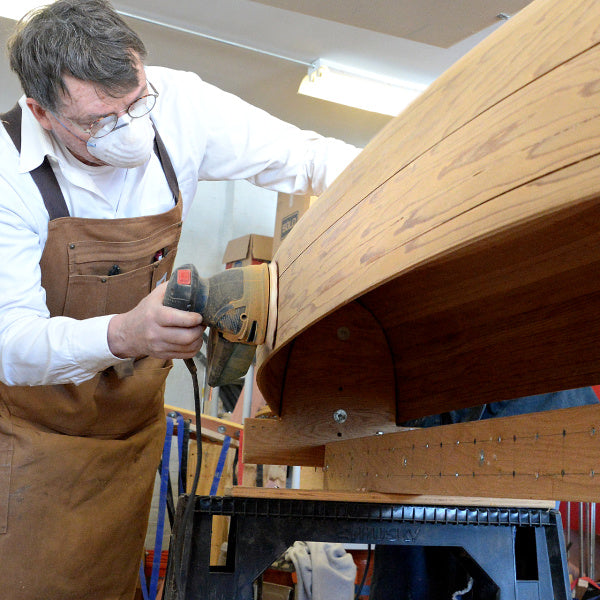Photographs courtesy of Scott Hayden, executive director of the Adirondack Folk School
“I met Jim Mandle at a dinner in Lake Luzerne,” explains Larry Benjamin, who teaches the Build a Wee Lassie Canoe class at The Adirondack Folk Museum. “My wife’s family has had a house in Lake Luzerne for four generations and I started building boats with my daughter and son when she was five and he was nine. Having the ability to make a boat that not only floats, but will last for generations, with your own hands with your children is almost indescribably rewarding. I love sharing this gift with others.”

Mandle founded The Adirondack Folk School in 2010 to help revitalize Lake Luzerne while also offering over-stimulated screen addicts the opportunity to slow down and learn the traditional ways of the Adirondacks, where creativity, self-reliance, sustainability, and cultural preservation are combined with traditional crafts to connect people from the past to the present, and into the future. Mandle bet that he’d have the support of locals in the ADKs (he was correct), and that interest from afar would follow (also correct).
“There is a real hunger for what we’re doing at the Adirondack Folk School,” Scott Hayden, executive director of the AFS, tells New York Makers. “Since opening the school in 2010, we’ve seen a more than 50% increase in student enrollment and classes that allow people to acquire a variety of skill sets, from soap-making to blacksmithing. Most of our students come without official skill sets, but they leave with not only a chair, a boat, a knife, or another object they created, but the knowledge that they have the power to do that.”
In 2010, AFS offered 90 classes; this year, they’re offering around 270.
While all of the classes look interesting (who wouldn’t want to learn how to cane a chair or forge a marshmallow roaster?), the one that captured our imagination was the canoe-crafting class.

Students who sign on for the class pay $2,000, which includes tuition and materials. All they have to bring is their hands and willingness to commit to long days — around seven hours — in the boat shop over a period of two weeks. They must arrive with an open mind, ready to work hard and build not just their own, but their entire class’ boats.
“We all work together, and we all contribute to each others’ boats, which is part of the communal spirit the Folk School hopes to impart,” Benjamin shares. “It also gives them a new level of confidence, because every boat is a little different and has its own set of challenges.”

Students hail from the surrounding region, as well as from Canada, Brooklyn, suburban Connecticut, Philly, and Boston. For 11 days, they toil together, often becoming friends.
“Occasionally a grandfather and granddaughter will come together, or a couple, but often people are solo, and from all over,” Benjamin explains. “But our shared goal brings us together, and it’s inspiring to see how a sense of camaraderie develops.”
Everything about the program is meticulously planned by Benjamin. He selected the Wee Lassie boat model because, like everything with an Adirondack soul, it’s a thing of beauty born of necessity.
“The model was popularized by the 19th century nature writer George Washington Sears,” Benjamin says. “He was about 100 pounds soaking wet, and, in order to really trek out into the Adirondacks the way he wanted to for his work and pleasure, he had to hire guides to help him carry his canoe and his pack before the advent of the Wee Lassie.”

The Wee Lassie is a lapstrake-built open cedar canoe made by J. Henry Rushton in the early 1860s in Canton. Sears adopted the canoe for his own use, crediting its light weight and maneuverability with freeing him from dependence on others. Benjamin says a child can steer the canoe solo, using kayak-style paddles, though traditional canoe paddles work just as well, he adds.
Everyone who makes a canoe in his class will be able to enjoy the same freedom. Benjamin himself has spent many days trekking the 6 million acre Adirondack Park with little more than a canoe, a pack, and his love of mountain and stream.
Benjamin and the Adirondack Folk School, unsurprisingly, are committed to environmental, as well as cultural, sustainability.
“All of the wood we use is sustainably harvested, and we use a range of cedar, mahogany, lace, and oak,” he says. “We use traditional tools for almost everything, except for things like sanding, which is extraordinarily time-consuming when done by hand. We want everyone, from the 5-year-old girl to her grandfather to leave with new skills, new confidence, and an heirloom-quality boat they can cherish and use.”
Does he use his regularly?
“Yes,” Benjamin says. “Being on the water in the Adirondacks, surrounded by mountains, with the sun shining down? In a boat I made myself? Oh yes. I use it every chance I get.”

A feeling of freedom, the open water, solitude. A gorgeous vessel that you handcrafted yourself using time-honored techniques. Sounds like the ideal summer to us.
Sign up here for the next Wee Lassie Canoe Building workshop beginning September 30!


Leave a comment